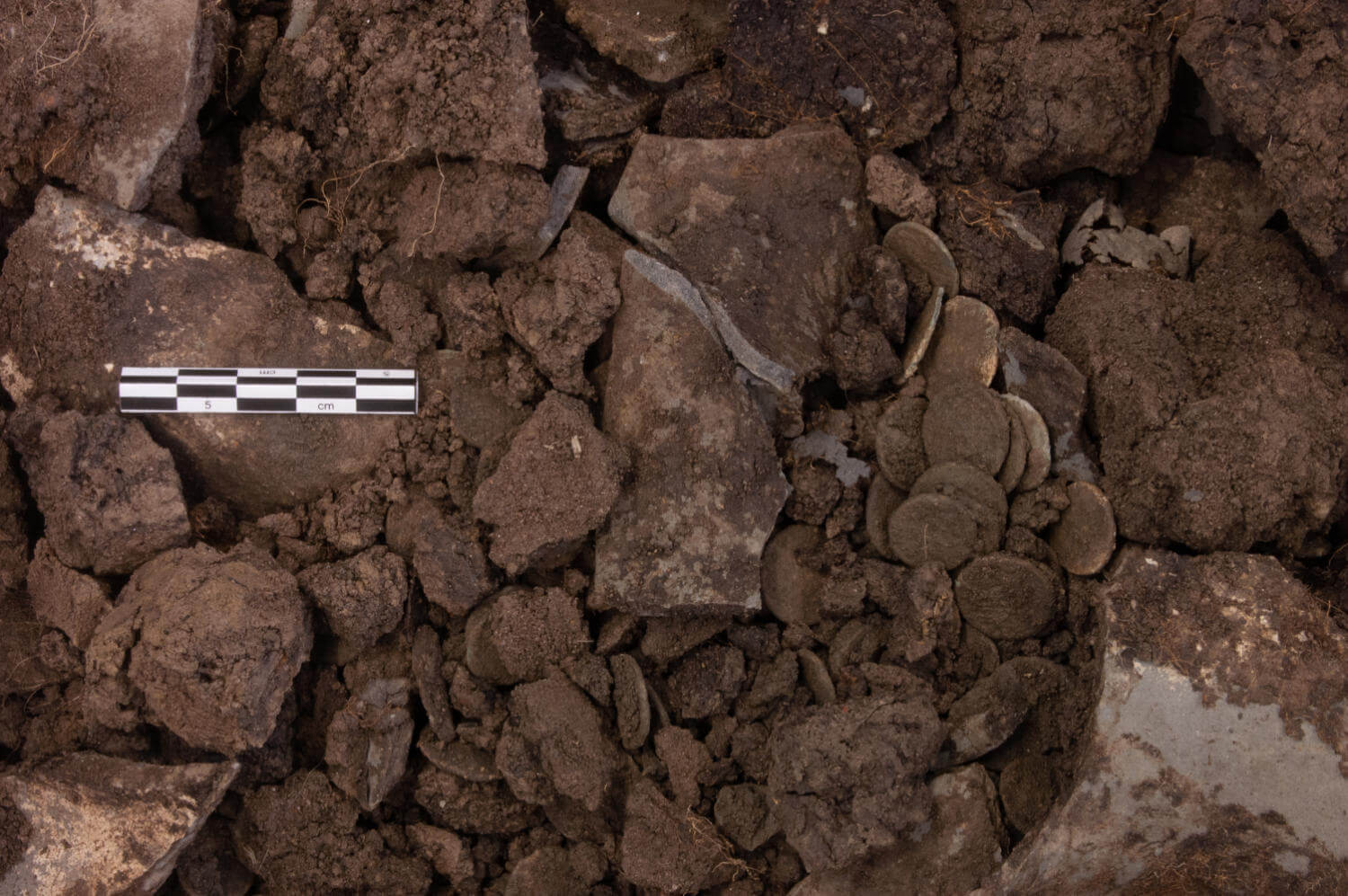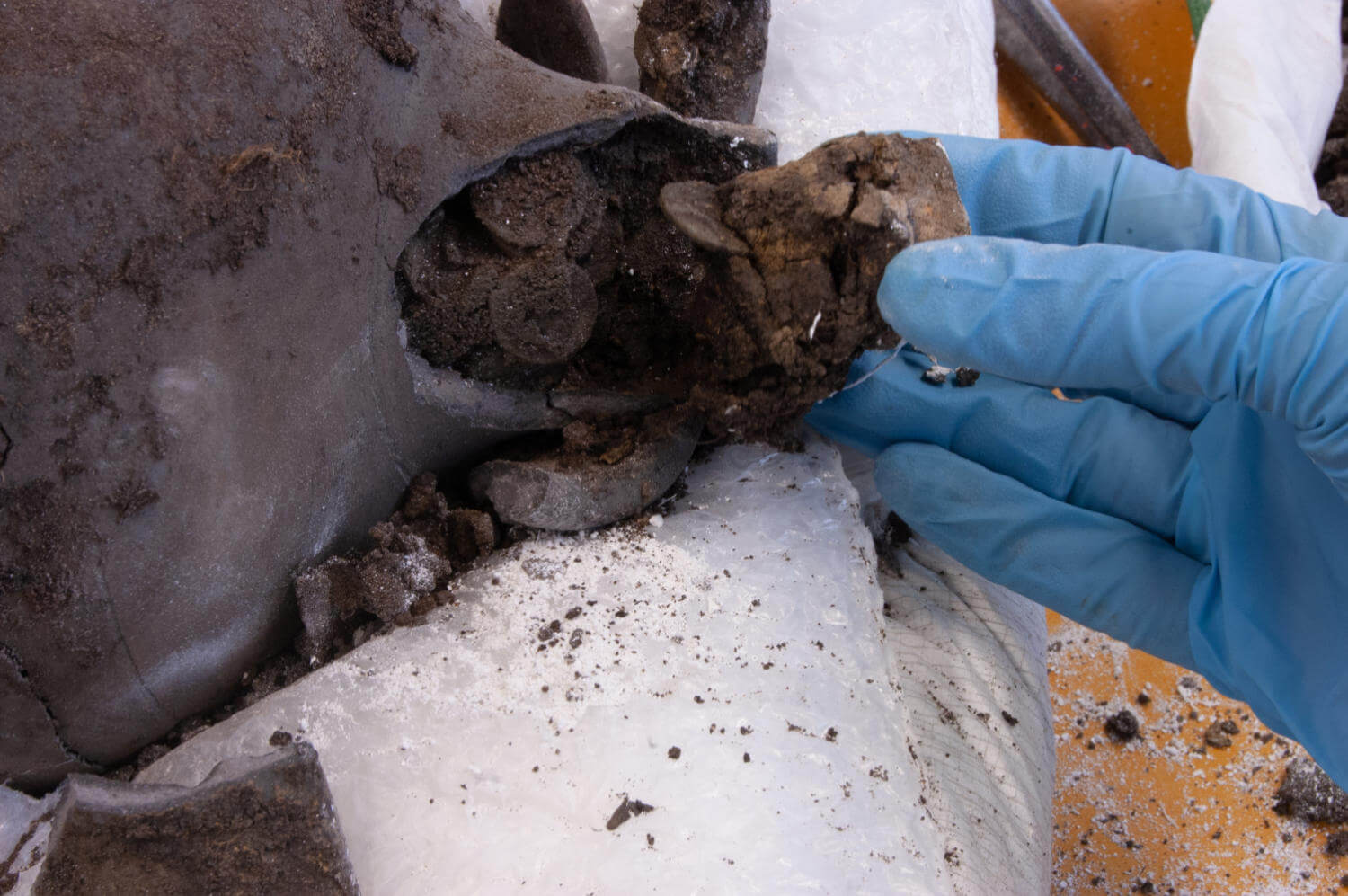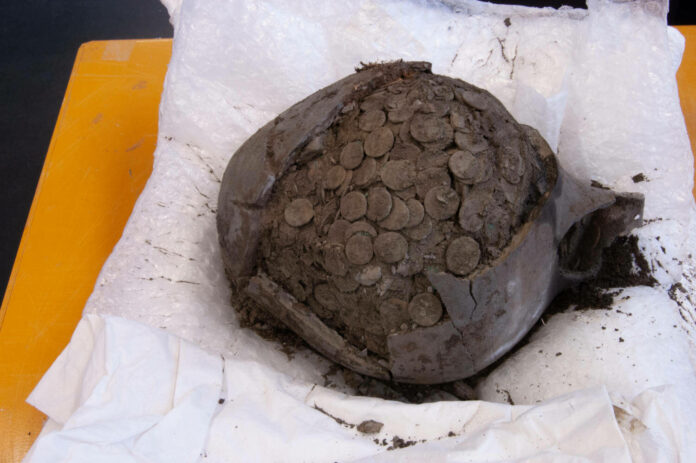
On 14 December 2021 at the British Museum, Arts Minister Lord Parkinson of Whitley Bay, launched the Treasure Annual Report for 2019 and the Portable Antiquities Scheme (PAS) Annual Report for 2020. These show that 49,045 archaeological finds were recorded throughout the first year of the pandemic. This number is lower than previous years as opportunities for metal-detectorists to record their finds were limited due to lockdowns and the impact of the Covid-19 pandemic.
The counties recording the most PAS finds in 2020 were East Yorkshire (5,584 finds), Norfolk (5,206) and Suffolk (4,048). For the same year, the areas where most Treasure was reported were Norfolk (104 cases), Hampshire (71) and Suffolk (57). These reports outline the work of the PAS in England and Wales, and the success of the Treasure Act 1996 across England, Wales and Northern Ireland.
Some of these finds include:
A Hoard of Roman Coins
A hoard of Roman coins found in three pots was found at Wickwar, Gloucestershire (GLO-CCC7BC) by metal detectorists Mark Lovell and Mark Wilcox. When the finders realised the coins were undisturbed and buried in the ground, they contacted the local Finds Liaison Officer (FLO), Kurt Adams, who organised an archaeological excavation to help preserve the hoard. The hoard was ‘block lifted’ to keep it intact and brought to labs at the British Museum where it was X-rayed and carefully micro-excavated. Conservation work revealed over 6,500 coins which dated to the 4th century AD from the three separate vessels, which seem to have been put in the ground at different times. During this period, many hoards were buried by Romans for safekeeping. A geophysical survey has been carried out on the site of the hoards to try and learn more about its past landscape, as it may be a previously unknown Roman site.
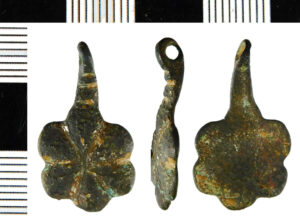
No 1 Million: A Medieval Harness Pendant
The 1 millionth record logged on the PAS database was a copper-alloy medieval harness pendant found in Binbook, Lincolnshire (NLM-B7AFF3). Over 1,500,000 finds have already been recorded by the PAS, but some database records include more than one item – in the case of a hoard, this can be several hundred items. Over 1,000,000 individual discoveries have now been found and offered for recording by public finders, many of whom are metal-detectorists, greatly adding to our understanding of Britain’s past.
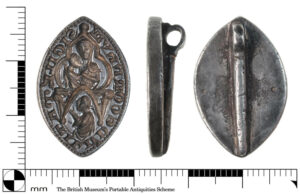
Silver Seal Matrix
An unusual silver medieval seal matrix dating to the early 13th century inscribed with the name Matilda de Cornhill was found at Hollingbourne, Kent (KENT-876D2D). Depicting a kneeling female figure, assumed to be a representation of Matilda herself, praying to the enthroned Virgin and Child – a well-known motif of the medieval period. The inscription in Latin reads SIGILL’MATILD’DECORDhVLL’, an abbreviation of SIGLLIVM MATILDA DE CORNHVLL (Seal of Matilda de Cornhill). Seal matrices from this period were usually made of copper-alloy or lead-alloy and were more commonly owned by men. As this matrix is made of silver and in a woman’s name, it is likely that Matilda was a person of status in her own right. Though we currently have no other documents with a seal using a similar matrix, ‘Maud’ and ‘Matilda’ were used interchangeably during this period; the owner may be Maud de Cornhill, the steward of St Augustine’s Abbey, Canterbury, whose husband was Reginald De Cornhill (active 1189–1215), High Sheriff of Kent and Constable of Rochester Castle.
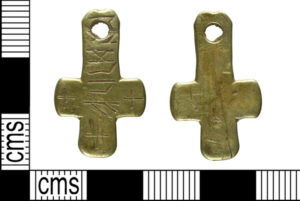
Gold Pendant With Rare Runic Inscription
A unique and mysterious early medieval gold pendant with a rare runic inscription was found in the North of England. The pendant, in the form of a cross, dates to around AD 700–900 and was found near to Berwick-upon-Tweed, Northumbria (DUR-B62F57). Runic inscriptions on objects are rare and even more uncommon on crosses, making this an exceptional object, with few clear parallels. Runic inscriptions often provide the name of a person associated with the object, such as its maker or owner. The text on this pendant comprises six runes, with two parallel scratches that may be an attempt to reinstate a rune that had been obliterated by the suspension hole. The runic inscription reads ‘ᛖᚫᛞᚱᚢᚠ’, which can be translated as Eadruf – likely a personal name. Intriguingly, this would be a “hitherto unknown and etymologically mysterious name” according to expert Professor John Hines (University of Cardiff) – potentially making Eadruf a new addition to recorded early medieval names. Berwick Museum and Art Gallery hopes to acquire.
Hartwig Fischer, Director of the British Museum, said: “The Portable Antiquities Scheme (PAS) is an essential part of the British Museum’s national activity, reaching out to people across the country to record their archaeological finds so that these can add to our knowledge of the past. If these finds are Treasure, they may benefit museum collections across England, Wales and Northern Ireland. Essential in this work is our partnerships with museums and heritage organisations across the UK, as well as those abroad where the PAS is admired and emulated.”
Arts Minister, Lord Parkinson of Whitley Bay, said: “Human beings have been fascinated by treasure from previous generations for centuries and these new statistics show the search for, and engagement with it, still captivates us today. I’m delighted that one million records of archaeological finds made by the public have now been logged. It shows the important role we all can play in protecting and cherishing our heritage.”
“It’s wonderful that so many treasure finds are now on display at museums across England, Wales and Northern Ireland for everyone to learn from and enjoy.”
Michael Lewis, Head of PAS and Treasure at the British Museum, said: “It is important to acknowledge the positive contribution made by metal-detectorists and other public finders across the country. If recorded, following the Code of Practice for Responsible Metal Detecting in England and Wales, these finds are transforming the archaeological map of Britain. No matter how small or fragmentary these finds are all part of the great jigsaw puzzle of our past.”
PAS at the British Museum
The British Museum’s PAS database holds information on over 1,554,000 items all freely accessible to the public. Most finds – over 91% of those discovered in 2020 – are made by metal detectorists. The British Museum supports a responsible approach to searching for finds as outlined in the Code of Practice for Responsible Metal-detecting in England and Wales that helps preserve our understanding of these objects and enhance knowledge of the past.
The PAS records archaeological finds discovered by the public to advance knowledge, tell the stories of past communities and further public interest in the past. It is a partnership project, managed by the British Museum in England and hosted through Amgueddfa Cymru – National Museum Wales in Wales, working with at least 98 national and local organisations, and delivered through its network of 40 locally based Finds Liaison Officers and supported by key staff at the British Museum and Amgueddfa Cymru – National Museum Wales, as well as the Welsh Archaeological Trusts, National Finds Advisers, interns and community volunteers.
The PAS report also outlines that in 2020:
- Finds made by 2,846 individuals were recorded.
- Over 93% of finds were found on cultivated land, where they are susceptible to plough damage and artificial and natural corrosion processes.
- Almost 99% of PAS finds were recorded to the nearest 100m, the minimum requirement for findspot information for Historic Environment Records.
- New sites discovered through finds recorded by the PAS include a Neolithic productive site in Hampshire, Bronze Age barrows in Wiltshire, a potential Roman villa in Cornwall, a Roman burial site in Cumbria, two possible Roman settlements in Oxfordshire, and what seems to be an Anglo-Saxon burial site in Warwickshire.
- Currently 337 researchers have full access to PAS data, and there are 53,130 registered account users in total. 823 research projects have used PAS data to date, including 57 major pieces of largescale research and 168 PhDs.
- 341,358 unique visitors visited the PAS websites and database, making 673,109 visits and 5,354,566 page requests.
- Publications associated with the work of the PAS include reports in Britannia, the British Numismatic Journal, Medieval Archaeology and Post-Medieval Archaeology, and the popular book Finds Identified II.
- At least 437 outreach events took place, including talks and finds days. Through these, PAS staff had direct contact with at least 7,451 adults and 192 children.
- Finds Liaison Officers had regular contact with 83 different metal-detecting clubs, and engaged with many other finders via email and social media.
- As of May 2021, 54 parties waived their right to a reward in 35 Treasure cases reported in 2019; this figure is likely to increase as cases are completed. Examples include a Bronze Age gold bracelet from near Brigg, North Lincolnshire (NLM-57BC11), acquired by North Lincolnshire Museum, where the landowner waived his reward, and a Roman gold jewellery fitting from near Sandwich, Kent (KENT-7C3C72), where both the finder and landowner waived their right to reward to enable Sandwich Guildhall Museum to acquire at no expense.
You can read all the details in the Treasure Annual Report for 2019 and the Portable Antiquities Scheme Annual Report for 2020.
You can find previous reports on this extremely successful project in our archive looking for “Portable Antiquities Scheme”.




